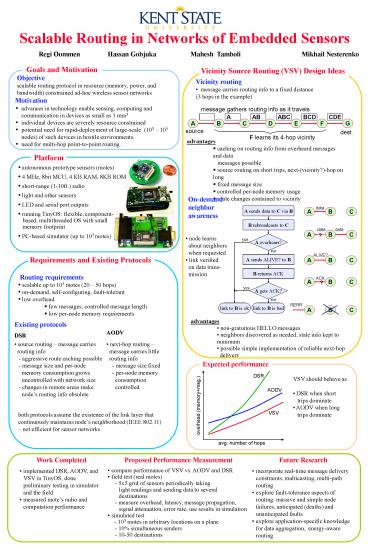Scalable Routing in Networks of Embedded Sensors - PowerPoint PPT Presentation
1 / 1
Title:
Scalable Routing in Networks of Embedded Sensors
Description:
scalable routing protocol in resource (memory, power, and bandwidth) ... for data aggregation, energy-aware routing compare performance of VSV vs. AODV and DSR – PowerPoint PPT presentation
Number of Views:83
Avg rating:3.0/5.0
Title: Scalable Routing in Networks of Embedded Sensors
1
Scalable Routing in Networks of Embedded Sensors
Regi Oommen Hassan Gobjuka
Mahesh Tamboli Mikhail Nesterenko
Objective scalable routing protocol in resource
(memory, power, and bandwidth) constrained ad-hoc
wireless sensor networks
- Vicinity routing
- message carries routing info to a fixed
distance (3 hops in the example)
- Motivation
- advances in technology enable sensing, computing
and communication in devices as small as 1 mm3 - individual devices are severely resource
constrained - potential need for rapid-deployment of
large-scale (103 105 nodes) of such devices in
hostile environments. - need for multi-hop point-to-point routing.
- advantages
- caching on routing info from overheard messages
and data messages possible - source routing on short trips,
next-(vicinity?)-hop on long - fixed message size
- controlled per-node memory usage
- route changes contained to vicinity
- autonomous prototype sensors (motes)
- 4 MHz, 8bit MCU, 4 KB RAM, 8KB ROM
- short-range (1-10ft.) radio
- light and other sensors
- LED and serial port outputs
- running TinyOS flexible, component- based,
multithreaded OS with small memory footprint - PC-based simulator (up to 103 motes)
On-demand neighbor awareness
- node learns about neighbors when requested
- link verified on data trans- mission
- Routing requirements
- scalable up to 103 motes (20 50 hops)
- on-demand, self-configuring, fault-tolerant
- low overhead
- few messages, controlled message length
- low per-node memory requirements
- advantages
- non-gratuitous HELLO messages
- neighbors discovered as needed, stale info kept
to minimum - possible simple implementation of reliable
next-hop delivery
Existing protocols DSR AODV
source routing message carries routing info - aggressive route caching possible - message size and per-node memory consumption grows uncontrolled with network size - changes in remote areas make nodes routing info obsolete next-hop routing message carries little routing info - message size fixed - per-node memory consumption controlled
- VSV should behave as
- DSR when short trips dominate
- AODV when long trips dominate
both protocols assume the existence of the link
layer that continuously maintains nodes
neighborhood (IEEE 802.11) not efficient for
sensor networks
Future Research
Proposed Performance Measurement
Work Completed
- incorporate real-time message delivery
constraints, multicasting, multi-path routing - explore fault-tolerance aspects of routing
massive and simple node failures, anticipated
(deaths) and unanticipated faults - explore application-specific knowledgefor data
aggregation, energy-aware routing
- compare performance of VSV vs. AODV and DSR
- field test (real motes)
- - 5x5 grid of sensors periodically taking
light readings and sending data to several
destinations - - measure overhead, latency, message
propagation, signal attenuation, error rate,
use results in simulation - simulated test
- - 103 motes in arbitrary locations on a plane
- - 10 simultaneous senders
- - 10-50 destinations
- implemented DSR, AODV, and VSV in TinyOS, done
preliminary testing in simulator and the field - measured motes radio and computation performance































